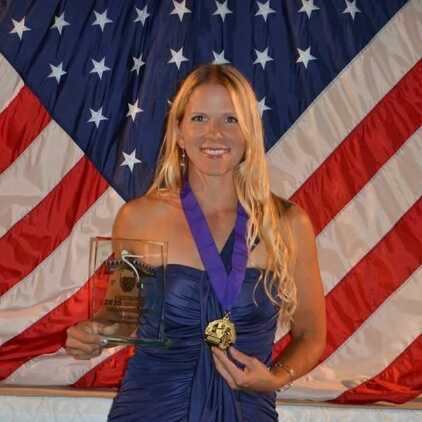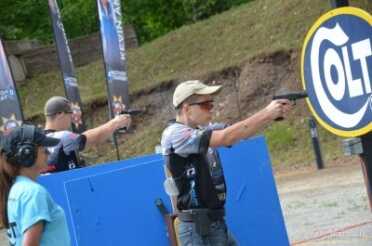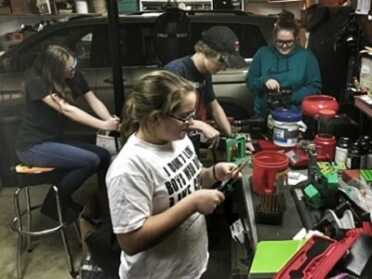
Becky Yackley, the author of the article. She’s no stranger to winning! Follow her 3-Gun adventures on Facebook.
Introduction:
As winter sets in and you find yourself indoors, contemplating what you can do to keep active and busy, you ought to consider competitive shooting. But I get why it may not be the first thing that comes to mind. That is, there are so many disciplines to choose from, and so many ways to begin, that unless you know someone already doing it, you might be a little intimidated. Fear not, as I have a plan on how you can become a competitive shooter!
My plan is a 12-part series, a journey into the fascinating world of competitive shooting. I’ll cover all sorts of ground and answer all sorts of questions along the way: Where do you start? What discipline should you choose? Where do you go? What guns and gear do you need? Among, many, many others.
Below you’ll find the list of episodes. It is my sincere hope that you’ll follow along with this series, ask questions in the comment section below and join me and the thousands of others who enjoy shooting competitively.
The Journey Into Competetive Shooting
Ep. 1 Getting Started
Ep. 2 Steel Challenge
Ep. 3 USPSA Pistol
Ep. 4 Shotgun
Ep. 5 3 Gun
Ep. 6 High-Power Rifle
Ep. 7 Cowboy Action
Ep. 8 Shotgun II
Ep. 9 IDPA
Ep. 10 Bulls Eye Pistol
Ep. 11 Smallbore Rifle
1. Go!
Above all else, you need to — as Nike says — just do it! Go! Get to the range!
See, everyone can talk. But to become a competitive shooter, at any level, means getting your butt out of that chair, moving your feet — and your hands, eyes, ears and, of course, using your brain. Just like the rest of life, nobody is going to do it for you. You have to be motivated. And frankly, if you just want people to hand you things, without doing work, this is not the sport for you. It’s a demanding sport, both physically and mentally. It requires setting steel, pasting targets, walking around in the cold, mud, rain, heat, dust and dirt. It requires great concentration and focus. It requires practice! Nobody becomes amazing while sitting on their couch.
But, if you’re willing to get your hands dirty and put in the work, shooting is one of the most rewarding sports you can be part of. And I can say from experience that practical shooting gives you a set of skills that carry over into other areas of your life and leaves you feeling confident, safe, and responsible — with a little adrenaline thrown in to boot!
2. Start simple
Rome wasn’t built in a day. Neither is the perfect competitive shooter. My advice is to pick a discipline that is basic and doesn’t require a lot of gear. Given this line of reasoning, steel challenge is perfect place to start, and from there you can branch out to USPSA, local trap, and skeet, maybe a multi-gun match or two (The video above is Becky’s son, Andrew Yackley, at a USPSA league night with Glock in hand and elf hat on head).
You don’t need to jump into competitive shooting at a major match, or even at a real match. Find a league night that you can go watch, then a local match. As I said, I’d recommend Steel Challenge or a Glock match.
Major matches require a bit more investment and you don’t want to go to one until you have guns and gear you’re confident using, as well as working knowledge of the safety rules and match process. Steel Challenge, which will be the second article in this series, requires a gun, magazines, ammo, eye and ear protection, and that’s about it. If you shoot Rimfire category, you don’t need a holster or anything special that an average person cannot get quickly or doesn’t already have in their possession.
3. Find a mentor
Nobody just jumps into shooting by themselves. You need knowledge, experience, and guidance. Nobody learns to shoot a gun without help. Most shooters have someone that brought them into the community, and that plays a huge role in what you can accomplish.
If you just go to a range where a match is held without knowing anyone, odds are you’re going to have a few jitters, not know the intricacies of the particular club and your experience isn’t going to be an engaging one. In short, you’ll feel like an outsider. So calling the range ahead of time and introducing yourself is a great idea!
At my club, new shooters stop by all the time and we make it a point to help them – we put them last on a squad so they can watch everyone else shoot a stage, we even allow them to spectate the first time if they choose. We have wives who come with husbands and watch for a few months until they want to try.
The crowd of people in shooting sports make it one of the best sports to be involved with. There are common values shared by people who want to share their love of what they are doing. And if you have a mentor, or, at least, a local group to practice with, you can learn from them, grow with them, and have a place to reach out to when you have questions.
4. Start carefully!
Start small, maintain control, and be safe! Then go fast, then run with guns! But always be safe! First, second, third…to infinity, it’s about safety!
The whole idea of practical shooting is to develop practical skills with your firearms so that if you need to use them, in real life, e.g. a self-defense situation, you can do so safely and accurately.
Basic rules like “finger off the trigger when you move,” stay within the 180, don’t sweep yourself, among many others are best learned by being deliberate when you begin. Dry fire, and practice changing magazines, your draw, your movement with a firearm — all these things practiced with a safe, empty gun build skill, confidence, and shape you into a competitor that others will welcome into the sport. Then when you go to the range, you are comfortable with processes, like changing mags without concern that your finger is on the trigger.
5. Make mistakes
Be ready to make mistakes. Everyone makes a lot of mistakes. It’s how we learn. So start slow and learn from your mistakes. As long as you’re safe when you make them, nobody will care. They will probably tell you a story about their own mistakes to set you at ease.
If your mistakes are ones you can grow from, you’ll look back in a year and laugh at how awkward you were. But once you put in enough time walking stages and learning the proper order of engagement on target presentations, or the best method to complete an empty the gun start, you will have a skill that is invaluable should you need to utilize your firearm under pressure.
The worst mistakes involve safety and that’s why you get a mentor, an extra set of eyes and hands, someone with a skill set and knowledge base that can save you from developing bad, and even dangerous, habits.
6. Give back to your community
The love you get is equal to the love you give. Right? Paul McCartney wrote that. And Sir. Paul is correct. The more we put into a sport, the more we get out of a sport. That’s is why I highly recommend that you give back to your gun community. Help at hunters education, local club matches, local shops or ranges. If you’re an advanced shooter or an instructor, do what you can to help others join in on the fun. If you’re a beginner, volunteer your time to learn the ropes.
You know, many programs at ranges are run by volunteers and they welcome your help. Even well-established ranges rely on local folks who come in to set up, clean up or maintain the range. Offer to help, become part of the club. You will find support on the local level is very beneficial — not only for the club but for you personally.
7. Plan to reload
Many people think shooting has to be very expensive. If you use a gun you already have, and shoot local matches without high entry fees and avoid costs from travel, your biggest cost is ammo. Even if you can’t reload yourself, buy reloads from a well-known source, save money until you know what gear and guns you need.
Offer to help a friend from a local club reload, even if just for the chance to learn. One group that reloads often are the range officers. Working as a range officer is another avenue of getting started in shooting and gathering your gear. ROs usually have free match entry, and can often earn brass when they volunteer to act as range officer. If you’re not experienced enough for that, you can still usually work a match under the supervision of an experienced RO. This is both a way to learn the sport and the rules, as well as to build enough time to decide what you really need, and what discipline you really want to shoot.
There are some pretty well-known ROing crews out there, David Power and his son Wyatt are well-respected in the 3 gun world. Another family that ROs often are Katie Francis with her dad, Chad Francis. Both families reload too, and both will tell you that they work to keep the cost down, it’s their way of giving back to their sport. And it highlights well the character young people build from being part of competitive shooting.
Conclusion

USA contingent at 2015 IPSC Shotgun World Shoot in Agna, Italy. USA ladies team: Lena & Kay Miculek, Di Muller, and Becky Yackley. Junior team: Tim Yackley, Katie Francis, Nate Staskiewicz, Brian Hampton.
The first step to shooting competitions is really taking any step. Make a call, research matches on the Internet, or drive to a local range and watch. Take a look at Enos Forums, or USPSA’s Web site. Search for monthly pistol matches, club 3 Gun or Steel Challenge. Find a local match, call and ask to attend or watch. Someone will take you under their wing. Experienced shooters love helping others. They also want safety in their sport, for you and them.
So find a club or match, call ahead, watch, listen, ask for help, offer help, and be safe. And get ready to make lifelong friends, with whom you’ll travel the world and make many happy memories. The people involved in the shooting sports become your second family! They are the quiet, responsible minority who see something bigger than themselves in the sport, they see the history behind the Second Amendment and what firearms mean to Americans, and to the world.
Here’re a few links to some great organizations that will help you get started: USPSA, MatchSignUp.org, Steel Challenge, DMOZ.
Equipment Check: The Guns and Gear to Get You Started
Guns
Obviously, we need these, but what type? That depends on the discipline or competition you’re jumping into. I can tell you what I like. For USPSA, I began with a Glock 34, shooting Production division. You don’t need mag extensions, or any modifications to the gun – you can just start shooting! As you decide what you want to focus on, you could add some grip tape to the pistol, better sights or improved trigger components. If you really like USPSA, you could even get mag extensions, lighten your trigger, and get set up for Limited division with the same pistol you started with.
For Steel Challenge, we used a Ruger Mark III or the a USPSA legal Glock. The biggest thing is to just pick something you have access to, that won’t break the bank, and think about a platform you can grow from. A Glock 34 or 17, an M&P, or FN pistol will get you going and you will have money left for ammo.
Eyes
I put wearing eye protection up there with the important rules of gun safety. You only have two eyeballs! It doesn’t matter if you wear fancy Oakleys or Walmart safety glasses but NEVER go without them. There is not only a concern from the gun and ammo, but from the dirt, steel, and lead from shooting.
Many matches have rules regarding how far you must be to engage steel, and they generally don’t set up steel where it can be shot closer than what is safe, but new shooters can underestimate the danger to their eyes from something like that. Even rocks in a berm or backstop can send debris back toward you – and your eyes. Sunglasses with an impact rating for safety are also good. The UV rays and bright light we encounter on the range can contribute to damage – so first, safety glasses, second ones that keep the sunlight from adding wear and tear to your eyes.
Ears
Shooting is loud! Until the Hearing Protection Act gets passed (go email your Senators and tell them to support this!) silencers are going to be an option only few have. Protect your ears by wearing ear pro every time you shoot. Double up foam plugs and muffs if shooting indoors.
For beginning shooters, the physical force of the sound can cause a flinch, an anticipation. If you are bringing a new shooter to the range make sure it’s good and quiet. It will help them learn. Even for those of us experienced in shooting, our body cannot stop certain reactions – if I reached out and pretended to slap your face, you’re going to flinch. A gunshot is much the same, your body has a physical reaction. Doing what you can to mitigate that will effect your shooting positively. Your recovery from shot to shot and ability to transition targets is going to be faster because you’re taking away some of the stimuli that tell you to slow down. We can’t override nature telling us something is loud, but we can work to lessen its effect.
Ammo
Don’t buy the cheapest ammo you can get. Get something you trust. You don’t have to go buy factory ammo for a practice session, but if you buy reloads, make sure it’s from a reputable source. Many of the big ammo companies make a practice-grade ammo.
When we first began, our local club had reloads available that were produced through a reputable source. It’s best to learn on ammo slowly and cautiously. Every experienced shooter will tell you that given enough time, you’re going to see some defective rounds: sideways primers, brass that has an imperfection, etc. The best thing you can do is inspect every round. This can be as simple as looking at the primers and the case as you load your mags, or using a case gauge, but you want to be aware of your ammo as you handle it and always look for imperfections.
Apparel
Shooting happens outside, so dress for the weather, dress for hot brass, dress for sun, cold, rain — just put a whole bag in your car with rain gear, boots, a change of shoes and socks. Bad weather makes a bad day. If you have rain gear to keep yourself from utter misery, it’s important to wear it. If you have a spare pair of shoes for wet days, bring them. Clean socks for a sandy range can save you from blisters, if your shoes get full of sand. Knee pads for rocky ranges.
Pants vs. Shorts: I don’t wear shorts for 3 Gun, even on the hottest days, because running and dropping into a position, hot rooftops, hot brass and any number of other problems like poison ivy are better avoided by wearing pants. For USPSA or pistol matches, shorts are an option, but again, could depend on the range. Bugs can be a problem. Pants can help with chiggers and mosquitos. As a woman, I will say hands-down the 5.11 Cirrus pants gives me the best setup for my belt and equipment.
Other Range Essentials:
A few things I pack in my car or shooting bag: sunscreen, chapstick, bug spray, water, band aids, athletic tape, eye drops (for dirt and dust), hand wipes in case I need to eat a snack or clean my glasses, protein, and packet of electrolyte drink. Electronic wipes for glasses – I’m sure they’re not the perfect thing for glasses, but I like them and carry them. I carry Benadryl and have given it to people allergic to bees. Ibuprofen, for headaches or the inevitable RO who’s limping from being on their poor feet all day. The wipes for hands isn’t just because I like wiping the dust and dirt off – when we reset steel targets, we are touching a surface that has been blasted with lead. We want to get that off before we eat! Protein and electrolytes of some sort.
***
About the author: Becky Yackley has been shooting competitively since she began as a teenager with service rifle and smallbore. She’s lived near the typical Marine Corps bases and spent 10 years near DC while her husband was active duty, but has settled into Wisconsin and shooting 3 Gun, USPSA, and Bianchi pistol with her three boys and husband. An avid runner and outdoorswoman, she shoots guns and photos, and sometimes her mouth…which her friends often remind her keeps them “alert” at late hours on road trips. Never known for being quiet, she’s bringing her brand of humor our way this year in hopes of sharing her love for shooting sports with our readers.








Thanks for your work and detail. GREAT ARTICLE! I only hope my wife gets as encouraged as I am about getting into the sport.
Becky! Awesome work. Maybe I’m a little biased, but I think you hit it out of the park. Really enjoyed reading it through. Have a great 2016 season with the fam!
Looking Pro Becky! I really enjoyed the series. See you on the circuit ninja!
Thanks Clay! See you this summer. Andrew’s going to get another mohawk because of you 🙂
Thank you for the great article. I recently ordered a Glock 34 and have been anxiously awaiting its arrival. I’m hoping to shoot USPSA and 3 Gun this spring, so I’ll be following your series!
Becky,
I enjoyed your article and like your writing style. I shot USPSA matches at my local range a couple of years ago, but haven’t been out in a while. Reading this motivates me to get back out there.
Mike,
Great to hear! I didn’t shoot much besides for fun and hunting when my kids were really young. But their interest and aptitude maybe it motivating to stretch out of what I’d done I to new things. Hope we see you out there!
This promises to be a great series! Can’t wait for the rest.
So much great information thank you!
Looking forward to this. I have shot a couple IDPA matches, Trap for a year and one Steel Challenge. I like the idea of starting with Steel Challenge to get my feet wet. Thanks Becky!
I second, great article! I will be watching for the series, and have a few new shooting buddies I will forward this to.
Not the same Greg, Thanks for reading, and definitely share away!
great article! I just started USPSA and would like to know more about three gun. I will look for more of your articles and Andrew looks Very Good! Nice job
Thank you Greg! Any parts of 3 gun you really want info on? I’d love to hear from people who are interested in it as I write!